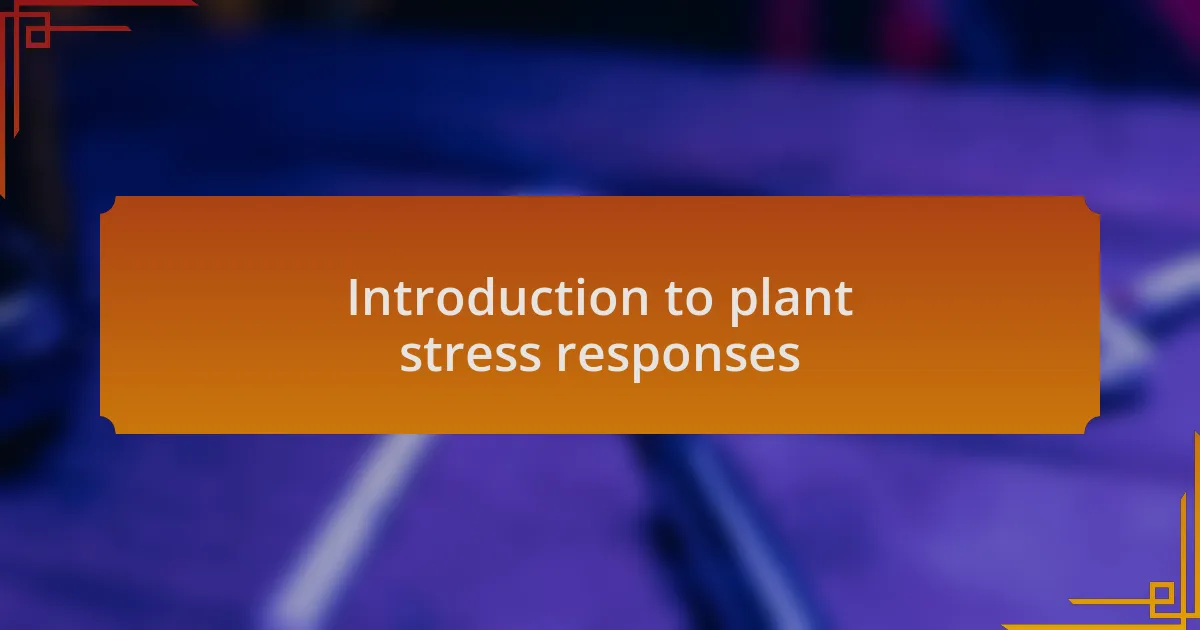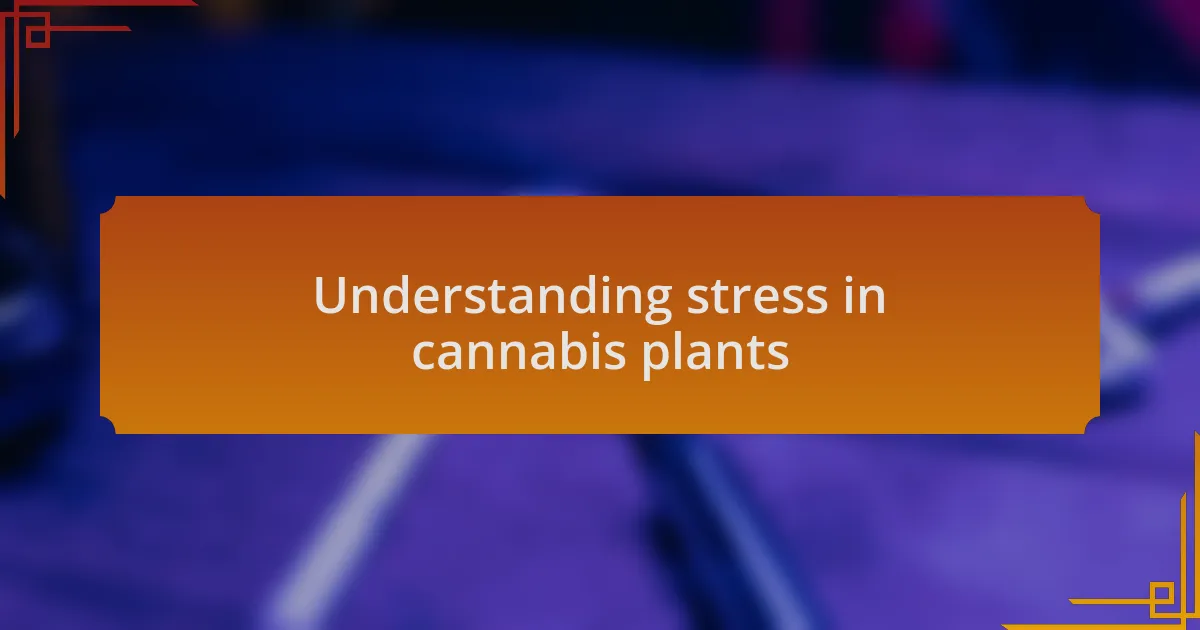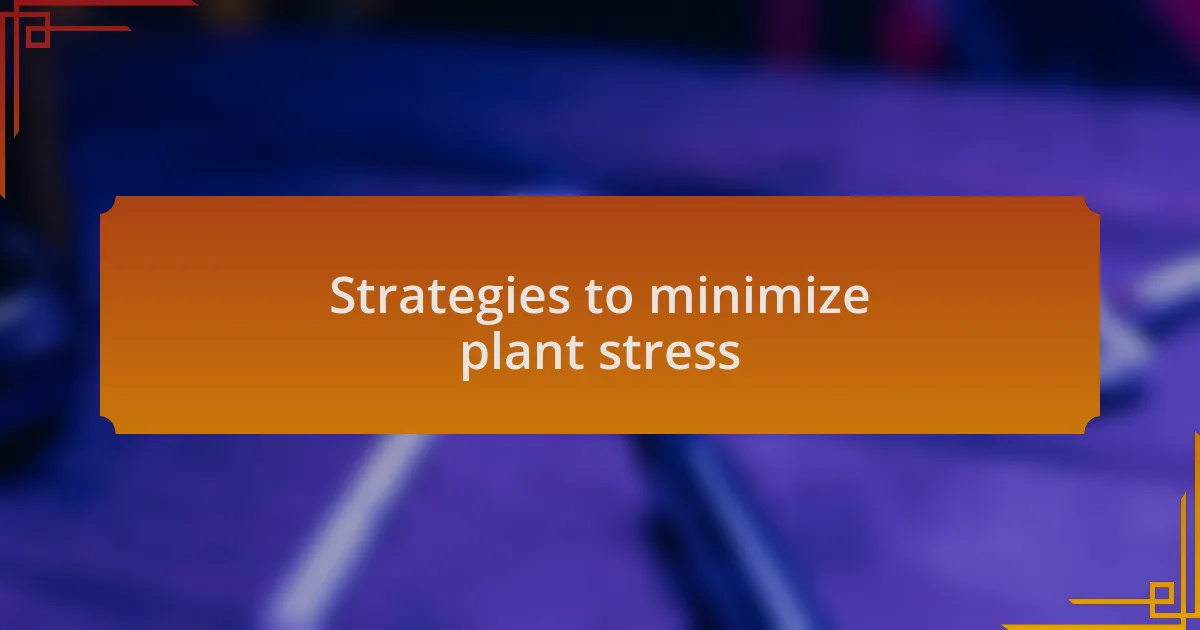Key takeaways:
- Plants, including cannabis, actively respond to stress, altering their growth and physiological traits as adaptations for survival.
- Common stress factors for cannabis include nutrient imbalances, temperature fluctuations, water stress, and pest infestations, each requiring careful attention from growers.
- Physiological responses to stress, such as changes in stomatal conductance and the production of protective secondary metabolites, can yield unexpected benefits like enhanced flavors and aromas.
- Effective strategies for minimizing plant stress involve creating optimal growing conditions, maintaining balanced nutrition, and being observant of environmental cues and plant needs.

Introduction to plant stress responses
Plants, much like us, experience stress, and it’s fascinating to realize how they respond to different challenges. I remember observing my cannabis plants struggling during a sudden heatwave; it was a heart-wrenching sight. Their drooping leaves and slowed growth made me wonder—how do plants communicate their distress?
Understanding plant stress responses is essential for anyone working with these botanical wonders. They’re not just passive organisms; they’re active participants in their survival, responding to environmental pressures like drought, nutrient deficiencies, or pest attacks. Reflecting on my own gardening experiences, I often think about the resilience of these plants. Have you ever noticed how a stressed plant might alter its growth or leaf shape? It’s a remarkable adaptation that speaks to their instincts for survival.
When I began delving deeper into the science, I found that the hormonal changes within plants during stress can resemble emotional responses in humans, which is quite profound. The shifts in their biochemistry not only highlight their struggle but also their capacity to fight back. Isn’t it incredible to think that every curled leaf could tell a story of resilience? Understanding these responses can truly transform how we nurture and care for our plants.

Understanding stress in cannabis plants
Cannabis plants face various stressors that can significantly impact their health and development. I recall one instance when a nutrient imbalance turned my vibrant green plants into a series of yellowing leaves. It dawned on me that this change wasn’t just a color shift; it signaled a deeper issue, a vivid reminder of how nutrient deficiencies could sabotage their growth. Have you ever watched a plant respond to a lack of nutrients, realizing how critical even tiny changes can be?
Another aspect of stress that always captures my attention is how environmental factors play a role in a cannabis plant’s resilience. I remember a time when my grow room became too humid, and I noticed the development of mold. This was not just a setback; it was a learning moment. It forced me to think about how these plants adapt to unfavorable conditions—isn’t it remarkable how they can modify their processes to survive? The psychological parallel to my own adjustments during tough times was striking; we all seek balance in chaotic environments.
Light stress, such as too much or too little light, is another factor that can dictate plant health. I learned this firsthand when I moved a few plants closer to the grow lights without considering their needs. The scorching seemed almost like a cry for help, showing me just how finely tuned these plants are to their surroundings. Can you imagine being subjected to extreme light variations? It made me appreciate the subtle cues plants provide to communicate their stress, urging us to be better caregivers in their moment of need.

Common stress factors for cannabis
When it comes to common stress factors for cannabis, one of the most prevalent is temperature fluctuations. I vividly remember one growing season when unseasonably cool nights put my plants through the wringer. Observing their reaction—the slowed growth and drooping leaves—was both alarming and enlightening. Have you ever seen your plants shiver in the cold? It’s a stark reminder that they too can feel vulnerable to drastic environmental changes, much like we do.
Water stress is another crucial factor that can make or break a cannabis crop. I learned this the hard way through neglect; during a particularly busy week, I forgot to check the moisture levels in my pots. When I finally did, the wilting leaves told me everything I needed to know. It really hit home that cannabis requires a careful balance—too much water can drown them, yet too little can leave them gasping. Isn’t it fascinating how these plants necessitate our attention to thrive?
Finally, pests pose a serious threat that can derail even the healthiest cannabis plants. I recall a time when I spotted spider mites wreaking havoc on my crop. It was disheartening to see these little invaders turn vibrant foliage into a shadow of its former self. This experience taught me that vigilance is key; recognizing signs early can save an entire harvest. Have you felt that mix of frustration and determination when battling unwanted guests in your garden? Each challenge, including pest management, has a way of fostering a deeper respect for our green companions.

Physiological responses to stress
When cannabis plants experience stress, their physiological responses can be quite telling. I once discovered that a sudden drop in humidity led my plants to develop thicker leaves as a defense mechanism. It’s fascinating to realize that while we may adjust our wardrobes for comfort, these plants adapt themselves to their environment for survival. Have you ever noticed a plant’s response to changes, almost as though it instinctively understands what it needs?
During high-stress periods, cannabis often exhibits specific physiological reactions, like changes in stomatal conductance—the tiny openings on leaves that regulate gas exchange. I remember checking the leaves of a particularly stressed-out strain, only to find them nearly closed up. It made me ponder how important it is for these plants to conserve water and energy during tough times, much like we might hold back during personal challenges. Isn’t it a testament to resilience that they can adjust their “breathing” based on their surroundings?
Moreover, stress can lead to the production of secondary metabolites, including cannabinoids and terpenes, which serve protective roles. I can recall a time when a friend’s plants were under considerable stress but ended up yielding some of the most aromatic buds I’ve ever encountered. This taught me that there can be unexpected rewards amidst challenges. Have you found that stress sometimes brings out the best in plants, much like it does in us?

Strategies to minimize plant stress
Minimizing plant stress involves creating an optimal environment for your cannabis plants. I remember a time when I invested in a reliable humidity controller, which made a world of difference during the dry months. By maintaining consistent humidity levels, I was able to prevent the plants from curling and developing those thick leaves as a reaction to strained conditions. Isn’t it amazing how such a simple adjustment can profoundly impact their growth?
Another effective strategy is to maintain a balanced nutrient regimen. There was a phase where I was experimenting with various fertilizers, and I learned that over-fertilizing caused my plants to droop and lose vibrancy. It was a harsh lesson that taught me the importance of moderation and observing how my plants reacted. Have you ever noticed that a little less might actually lead to more vibrant growth?
Moreover, I’ve discovered that timing my watering can drastically reduce stress. I recall a period when I tried a more flexible watering schedule instead of sticking to a strict daily routine. The plants thrived with deeper roots and more resilience because they were encouraged to search for moisture. Doesn’t it make sense that giving them the opportunity to adapt strengthens their resolve?

Lessons learned from my experiences
Throughout my journey, I learned that paying attention to environmental cues can make a significant difference. I once had a batch of seedlings that showed signs of early stress due to fluctuating temperatures. By simply investing in a small heater for the colder nights, I witnessed these young plants flourish, reaffirming my belief that a stable environment fosters healthy growth. Have you noticed how responsive your plants can be to even minor adjustments?
Another lesson I embraced was the power of observation. One time, I thought I could speed up growth by pruning early. Instead, I realized I stressed the plants unnecessarily, which delayed their development. This taught me the importance of timing and patience—it’s like nurturing a friendship; sometimes, giving space leads to stronger bonds. Have you ever jumped the gun, only to realize the value of restraint?
Lastly, I found that introducing beneficial insects can create a balanced ecosystem around my plants. Early on, I was hesitant, fearing I might worsen pest problems. However, when I finally decided to release ladybugs, I was amazed at how they kept the pests at bay while promoting a healthy environment. It’s fascinating how nature has its way of finding balance; can you imagine the impact of inviting harmony rather than fighting battles?